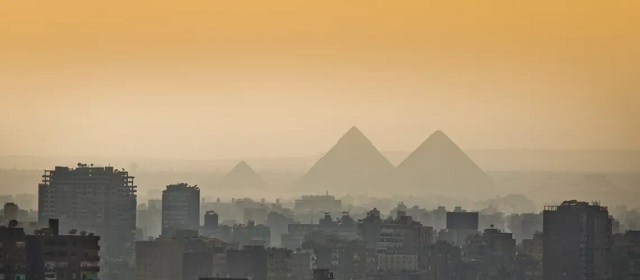
By: Nobuhiko Daito, Dahlia Lotayef, and Arturo Ardila-Gomez
The following story was originally published on Arab Voices
KGGTF Grant: Egypt Green Transport Master Plan and Data Management System to Support Digital Transformation of the Transport Sector and Intelligent Transport Systems
Air pollution has been a problem for Egyptians for decades, particularly in large cities such as Cairo. In Greater Cairo, levels of the fine particulate matter PM10 and PM2.5, that pose the greatest risk to people’s health are several times higher than the levels the World Health Organization (WHO) recommends. Egypt’s health ministry says that in the country as a whole, as many as two million people a year seek medical treatment for respiratory problems related to poor air quality.
Climate change is also a problem for Egypt. Climate models predict that Egypt’s mean annual temperatures will rise by 2 to 3 degrees Celsius by 2050, increasing both the duration of heatwaves and frequency and severity of droughts.
We find it encouraging that Egypt is taking steps to mitigate the impact both of air pollution and of climate change. Its Vision 2030 has set a target of reducing PM10 small particulate matter concentrations by 50% by 2030. The country has formulated a Greenhouse Gas (GHG) emissions reduction action plan, the Intended Nationally Determined Contribution (INDC), as part of its commitment to the Paris Climate Agreement, the UN’s Framework Convention on the 2021 Climate Change Conference of Parties (COP21).
Sustainable transport is a pillar of the Egyptian carbon emission mitigation strategy. Egypt has invested in public infrastructure, such as Cairo’s Metro Line 3 and its extension, reducing the number of cars on the city’s roads by 13% and bringing annual average PM10 levels in Greater Cairo down by over 3% in 2017. Reductions in government fuel subsidies—slashed under Egypt’s homegrown 2016-19 reform program supported by the World Bank/IMF 2016–19 —are estimated to have decreased the number of cars on Cairo’s roads by up to 14%, cutting PM concentrations by 4% by 2019 compared to 2016.
Egypt’s sustainable transport program also includes promoting non-motorized transport, improving freight energy efficiency, and strengthening institutional capacity.
The Greater Cairo Air Pollution Management and Climate Change Project involves cross-sector engagement by the government departments responsible for solid waste removal, public transport, and public health. Financed by the World Bank, it includes the purchase of about 100 battery electric buses (e-buses) by the Ministry of Environment, which will work with its Environmental Affairs Agency, Cairo Governorate, and the Cairo Transport Authority, among others, to implement the project.
We used data analysis produced by the World Bank’s sustainable development and infrastructure units to inform the project’s design. Through innovative analytics techniques, our environment team identified that public transport was important to addressing the air pollution caused by emissions from diesel buses in Greater Cairo. The Egypt E-Mobility White Paper, prepared by the Bank’s energy and transport teams, found that public transport, rather than personal vehicles, would be a suitable category to electrify because of its manageable potential for reducing high GHGs.
Decarbonization is a core element of the Bank’s Green, Resilient and Inclusive Development (GRID) approach and action plan to help countries tackle climate change. To strengthen the sustainability of such an investment, the Global Facility for Disaster Reduction and Recovery will help design measures to mitigate the impact of disasters like climate change to complement the project.
This project will therefore approach the idea of introducing an e-bus fleet not just as an experiment to test the viability of the technology itself but as a strategic step in lessening air pollution and mitigating the impact of climate change in Egypt. In transport strategies, decarbonization goes far beyond replacing vehicles with internal combustion engines with electric cars; it involves a shift away from cars. Our GHG analysis found that over 90% of the reduction in carbon emissions would need to come from a shift away from using cars and taxis; replacing diesel buses with e-buses constituted only 9.5% of the reduction.
As a first step, designing the project to provide a high-quality bus service—in terms of frequency, air conditioning, and onboard USB sockets for charging passengers’ electronic devices—could encourage a major change in the public’s travel patterns. The project builds on e-mobility experiences elsewhere in Egypt. In Alexandria, on the Mediterranean, the Public Transport Authority found that a well-designed fleet of electric buses would lead to an increase in popular demand for bus trips, even among women, particularly where perceptions of public safety were improved by installing security cameras in buses.
The way ahead is not without its challenges: earlier research has suggested that operational issues—battery range and weight, charging technologies and infrastructure costs, scalability and flexibility—need to be resolved for e-buses to succeed in Egypt. The first phase of the Greater Cairo Air Pollution Management and Climate Change Project will look at potential bus routes and include detailed bus design, the retrofitting of depots to integrate recharging, the operational environment overall, and whatever else is needed to make e-buses feasible.
